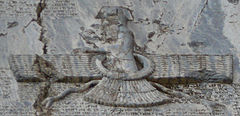Mannaea
 |
| History of Greater Iran |
|---|
The Mannaeans (or Mannai, Mannae, Biblical Minni, מנּי) were an ancient people of unknown origin, who lived in the territory of present-day Iran, around the 10th to 7th centuries BC. At that time they were neighbors of the empires of Assyria and Urartu, as well as other small buffer states between the two, such as Musasir and Zikirta.
Their original homeland was situated east and south of the Lake Urmia, roughly centered around modern-day Mahabad,[2] and at their greatest extent their borders expanded as far as the Kura river. Excavations that began in 1956 succeeded in uncovering the fortified city of Hasanlu, once thought to be a potential Mannaean site. More recently, the site of Qalaichi (possibly ancient Izirtu/Zirtu/Zikirtu) has been linked to the Mannaeans. After suffering several defeats at the hands of both Scythians and Assyrians, the remnants of the Mannaean populace were absorbed by Iranic people who were known as Matiani. The area became known as Matiene and was annexed by the Medes in 616 BC.
Ethnonym
Minni in Jeremiah (Jeremiah 51:27) is mentioned alongside Ararat and Ashchenaz, probably the same as the Minnai of Assyrian inscriptions,[1] perhaps corresponding to the Minyans.[2] Armenia is interpreted by some as ḪARMinni, that is, "the mountainous region of the Minni", see Armenia (name).[3] S. Bochard in his Geographia Sacra identified the Minni with Minyades, mentioned by Nicholas of Damascus as a province of Armenia. J. P. Hyatt in the Interpreter's Bible identifies them with the Mannaeans known from Assyrian inscriptions, located in the region south of Lake Urmia.
Ethnicity
According to the Encyclopedia Iranica[4]:
It is unlikely that there was any ethnolinguistic unity in Mannea. Like other peoples of the Iranian plateau, the Manneans were subjected to an ever increasing Iranian (i.e. Indo-European) penetration. Boehmer's analysis of several anthroponyms and toponyms needs modification and augmentation. Melikishvili (1949, p. 60) tried to confine the Iranian presence in Mannea to its periphery, pointing out that both Daiukku (cf. Schmitt, 1973) and Bagdatti were active in the periphery of Mannea, but this is imprecise, in view of the fact that the names of two early Mannean rulers, viz. Udaki and Azā, are explicable in Old Iranian terms.
History
The kingdom of Mannai began to flourish around 850 B.C. Mannaeans were mainly a settled people, practicing irrigation and breeding cattle and horses. The capital was another fortified city, Izirtu (Zirta).
By the 820s BC they had expanded to become the first large state to occupy this region, later followed by the Medes and the Parsu (Persians). By this time they had a prominent aristocracy as a ruling class, who somewhat limited the power of the king.
Beginning around 800 BC, the region became contested ground between Urartu, who built several forts on the territory of Mannae, and Assyria. During open conflict between the two, ca. 750-730 BC, Mannae seized the opportunity to enlarge its holdings. The Mannaean kingdom reached the pinnacle of its power during the reign of Iranzu (ca. 725-720 BC).
In 716 BC, king Sargon II of Assyria moved against Mannae, where the ruler Aza, son of Iranzu, had been deposed by Ullusunu with the help of the Urartians. Sargon took Izirtu, and stationed troops in Parsuash (original home of Persian tribe, on lake Urmia) and Kar-Nergal (Kishesim). The Assyrians thereafter used the area to breed, train and trade horses.
According to one Assyrian inscription, the Cimmerians (Gimirru) originally went forth from their homeland of Gamir or Uishdish in "the midst of Mannae" around this time. The Cimmerians first appear in the annals in the year 714 BC, when they apparently helped the Assyrians to defeat Urartu. Urartu chose to submit to the Assyrians, and together the two defeated the Cimmerians and thus kept them out of the Fertile Crescent. At any rate, the Cimmerians had again rebelled against Sargon by 705, the year he fell to them in battle, and by 679 they had migrated to the east and west of Mannae.
The Mannaeans are recorded as rebelling against Esarhaddon of Assyria in 676 BC, when they interrupted the horse trade between Assyria and Parsuash.
The king Ahsheri, who ruled until the 650s BC, continued to enlarge the territory of Mannae. However, Mannae suffered a crushing defeat at the hands of the Assyrians around 660 BC, and revolt broke out, continuing until Ahsheri's death. Also in the 7th century BC, Mannae was defeated by the advancing Scythians, who had already encroached upon Urartu, somewhat later (585 BC) destroying it as well. This defeat contributed to the further break-up of the Mannaean kingdom.
King Ahsheri's successor, Ualli, took the side of the Assyrians against the Medes (Madai), who were at this point still based to the east along the Southwest shore of the Caspian Sea. However, in the ensuing decades of conflict, it appears the Medes eventually gained the upper hand, conquering the remnants of Mannae in 616 BC and absorbing the populace.
References
External links
- Mannaean art
- Kingdom of Mannai Regnal chronologies
- Mannaean glazed bricks from Bukan
